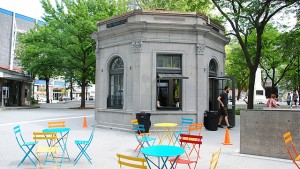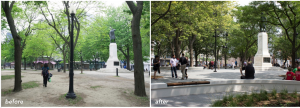In 1870, Cabot Square was opened upon land gifted to the city from the Sulpicians. Initially, the space’s central feature was a fountain, but in 1935 a statue of explorer John Cabot – donated by the Italian community – replaced it.
The portrayal of Cabot is problematic; using tropes of monumental sculpture, it perpetuates a narrative of European explorers discovering a “new world”. Cabot’s image is thus meant to remind the viewer of the official version of Canadian nation-building, while marginalizing alternative perspectives; most notably those of Indigenous peoples.
Ironically enough, in the decades that followed Cabot Square became a gathering site for urban Indigenous peoples from across the country; the space is especially important to many homeless Indigenous of Montreal, who often lack the ability to articulate their identity in the urban setting due to both economic and symbolic disenfranchisement.
Recently, the municipal government enacted an urban renewal plan that led to the renovation of Cabot Square. The project included a permanent use for the building in the park, better lighting, the addition of garbage bins, and the paving of pathways, among other details. Importantly, the plan also included a permanent police presence through the stationing of a liaison officer in the area.
To facilitate this process, the city also launched the Montreal Urban Aboriginal Community Strategy (RÉSEAU). The organizations’ objectives were to present a portrait of Cabot Square from the point of view of the Indigenous community located there, as well as the development of solutions to improve safety and wellbeing through a “collaborative and coordinated approach”.
In practice, once the Square re-opened after many months of renovations, there were a few significant additions to it. The Indigenous-operated Roundhouse Café was opened in the rotunda on the west side, and 2 outreach workers now have an office on site. The space also began to host events such as International Indigenous Day celebrations and weekly soapstone carving workshops.
Notably, there is a tension evidenced by all these interventions; the planning policy of city had on one hand sought to “clean up” the park and focused its objectives in security terminology, while on the other hand devoted its resources to promoting a sense of community in the space.
The fact that the Cabot Statue—a symbol of colonial authority—should remain the central focus of the Square even after the renovation seems inconsistent with RÉSEAU’s goal of empowering Montreal’s Urban Indigenous community. The problem of a colonial monument presiding over a gathering space for Montreal’s dispossessed Indigenous peoples remains unaddressed. The intervention we have imagined engages with this problem, and aims to situate itself within and contribute to the outreach already being done in the space by advancing a discussion of the historical narratives present in Cabot Square.
The first component of our proposed intervention is a community led planting of vines at the base of the Cabot monument. Over the course of a season, the vines would grow to form a living wall which would cover the statue entirely. Cabot’s figure would be obscured, but the form of the monument would remain in the landscape of the park, symbolizing a challenge to the authority of the historical narrative implicit in the statue. The aim of the living wall is to dispel the notion that any common or universal historical understanding is possible in a space as nuanced as Cabot Square, undoing the work of the State-sponsored colonial monument.

The second component of our intervention is a collection of oral testimonies, gathered from interviews with people who have lived and gathered in Cabot Square. The testimonies will be accessible online via smartphone, through a QR code that will be installed on a placard near the newly-covered monument. We will employ existing community networks such as RÉSEAU to seek participants. The audio component emphasizes the importance of oral tradition, suggesting a continued detachment from authoritative knowledge systems. A central theme of our intervention is the deference of historical authority to a living voice within the Montreal Indigenous community, and as such we will allow their testimony and narratives to shape our project, including whatever broader questions of colonial relations it might imply.



